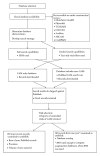Searching for controlled trials of complementary and alternative medicine: a comparison of 15 databases
- PMID: 19468052
- PMCID: PMC3137728
- DOI: 10.1093/ecam/nep038
Searching for controlled trials of complementary and alternative medicine: a comparison of 15 databases
Abstract
This project aims to assess the utility of bibliographic databases beyond the three major ones (MEDLINE, EMBASE and Cochrane CENTRAL) for finding controlled trials of complementary and alternative medicine (CAM). Fifteen databases were searched to identify controlled clinical trials (CCTs) of CAM not also indexed in MEDLINE. Searches were conducted in May 2006 using the revised Cochrane highly sensitive search strategy (HSSS) and the PubMed CAM Subset. Yield of CAM trials per 100 records was determined, and databases were compared over a standardized period (2005). The Acudoc2 RCT, Acubriefs, Index to Chiropractic Literature (ICL) and Hom-Inform databases had the highest concentrations of non-MEDLINE records, with more than 100 non-MEDLINE records per 500. Other productive databases had ratios between 500 and 1500 records to 100 non-MEDLINE records-these were AMED, MANTIS, PsycINFO, CINAHL, Global Health and Alt HealthWatch. Five databases were found to be unproductive: AGRICOLA, CAIRSS, Datadiwan, Herb Research Foundation and IBIDS. Acudoc2 RCT yielded 100 CAM trials in the most recent 100 records screened. Acubriefs, AMED, Hom-Inform, MANTIS, PsycINFO and CINAHL had more than 25 CAM trials per 100 records screened. Global Health, ICL and Alt HealthWatch were below 25 in yield. There were 255 non-MEDLINE trials from eight databases in 2005, with only 10% indexed in more than one database. Yield varied greatly between databases; the most productive databases from both sampling methods were Acubriefs, Acudoc2 RCT, AMED and CINAHL. Low overlap between databases indicates comprehensive CAM literature searches will require multiple databases.
Similar articles
-
Indexing of randomised controlled trials of physiotherapy interventions: a comparison of AMED, CENTRAL, CINAHL, EMBASE, hooked on evidence, PEDro, PsycINFO and PubMed.Physiotherapy. 2009 Sep;95(3):151-6. doi: 10.1016/j.physio.2009.01.006. Epub 2009 Apr 23. Physiotherapy. 2009. PMID: 19635333 Review.
-
Literature searching for clinical and cost-effectiveness studies used in health technology assessment reports carried out for the National Institute for Clinical Excellence appraisal system.Health Technol Assess. 2003;7(34):iii, ix-x, 1-51. doi: 10.3310/hta7340. Health Technol Assess. 2003. PMID: 14609481 Review.
-
A comparison of the performance of seven key bibliographic databases in identifying all relevant systematic reviews of interventions for hypertension.Syst Rev. 2016 Feb 9;5:27. doi: 10.1186/s13643-016-0197-5. Syst Rev. 2016. PMID: 26862061 Free PMC article.
-
Handsearching still a valuable element of the systematic review.Evid Based Dent. 2008;9(3):85. doi: 10.1038/sj.ebd.6400602. Evid Based Dent. 2008. PMID: 18927572
-
Methodological developments in searching for studies for systematic reviews: past, present and future?Syst Rev. 2013 Sep 25;2:78. doi: 10.1186/2046-4053-2-78. Syst Rev. 2013. PMID: 24066664 Free PMC article.
Cited by
-
The Multidisciplinary Approach to Alzheimer's Disease and Dementia. A Narrative Review of Non-Pharmacological Treatment.Front Neurol. 2018 Dec 13;9:1058. doi: 10.3389/fneur.2018.01058. eCollection 2018. Front Neurol. 2018. PMID: 30619031 Free PMC article. Review.
-
A systematic review of acupuncture for chemotherapy-induced peripheral neuropathy.Curr Oncol. 2019 Apr;26(2):e147-e154. doi: 10.3747/co.26.4261. Epub 2019 Apr 1. Curr Oncol. 2019. PMID: 31043820 Free PMC article.
-
Optimizing literature search in systematic reviews - are MEDLINE, EMBASE and CENTRAL enough for identifying effect studies within the area of musculoskeletal disorders?BMC Med Res Methodol. 2016 Nov 22;16(1):161. doi: 10.1186/s12874-016-0264-6. BMC Med Res Methodol. 2016. PMID: 27875992 Free PMC article.
-
The effectiveness of moxibustion: an overview during 10 years.Evid Based Complement Alternat Med. 2011;2011:306515. doi: 10.1093/ecam/nep163. Epub 2011 Jun 23. Evid Based Complement Alternat Med. 2011. PMID: 19825873 Free PMC article.
-
The pharmacological and non-pharmacological treatment of attention deficit hyperactivity disorder in children and adolescents: protocol for a systematic review and network meta-analysis of randomized controlled trials.Syst Rev. 2015 Feb 27;4:19. doi: 10.1186/s13643-015-0005-7. Syst Rev. 2015. PMID: 25875125 Free PMC article.
References
-
- Barnes PM, Powell-Griner E, McFann K, Nahin RL. Complementary and alternative medicine use among adults. Advance Data From Vital and Health Statistics no. 343, National Center for Health Statistics, Hyattsville, Md, USA, June 2008, http://nccam.nih.gov/news/camstats.htm. - PubMed
-
- Eisenberg DM, Davis RB, Ettner SL, et al. Trends in alternative medicine use in the United States, 1990–1997: results of a follow-up national survey. Journal of the American Medical Association. 1998;280(18):1569–1575. - PubMed
-
- Phillips B, Ball C, Sackett D, Badenoch D, Straus S, Haynes B, et al. Oxford Centre for Evidence-based Medicine levels of evidence. Centre for Evidence-Based Medicine (CEBM), Oxford, UK, June 2008, http://www.cebm.net/index.aspx?o=1025.
Grants and funding
LinkOut - more resources
Full Text Sources


